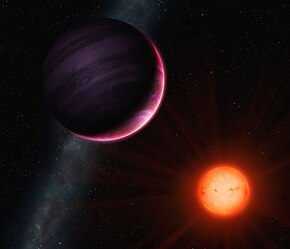NGTS-1b
 artist's concept of exoplanet NGTS-1b | |
| Discovery | |
|---|---|
| Discovered by | Next-Generation Transit Survey[1] |
| Discovery date | 2017 |
| NGTS telescopestogether withEulerCam photometricandHARPS spectroscopyfollowups. | |
| Orbital characteristics | |
| 0.0326 AU (4,880,000 km)[2] | |
| Eccentricity | 0.016[2] |
| 2.6473 JD[2]d | |
| Inclination | 82.8[2] |
| Star | NGTS-1[3] |
| Physical characteristics | |
| 1.33[2]RJ | |
| Mass | 0.812[2]MJ |
| Temperature | 790.0[2]K |
NGTS-1bis a confirmedhot Jupiter-sizedextrasolar planetorbiting NGTS-1, ared dwarfstar about half the mass and radius of theSun,every 2.65 days.[4]TheNGTS-1system is about 716light-yearsfromEarthin theColumbaconstellation.[3][1][5]
Discovery
[edit]The exoplanet, NGTS-1b, was discovered by theNext-Generation Transit Survey.[1]Daniel Bayliss, of theUniversity of Warwick,and lead author of the study describing the discovery of NGTS-1b, stated, "The discovery of NGTS-1b was a complete surprise to us—such massive planets were not thought to exist around such small stars—importantly, our challenge now is to find out how common these types of planets are in the Galaxy, and with the new Next-Generation Transit Survey facility we are well-placed to do just that."[5]
Characteristics
[edit]Mass, radius and temperature
[edit]NGTS-1b is a hot Jupiter-sizedgas giant exoplanetthat has a mass of 0.812 MJand a radius of 1.33 RJ,where MJand RJare the mass and radius ofJupiter.[3][1]
Host star
[edit]The planet orbits an M0.5 dwarf star about half the mass (0.617M☉) and radius (0.573R☉) of theSun.[1][2]
Orbit
[edit]NGTS-1b orbits about 4.5 million km (2.8 million mi) from the host star every 2.6473 Earth-days.[3][1][2][6]
See also
[edit]References
[edit]- ^abcdefLewin, Sarah (31 October 2017)."Monster Planet, Tiny Star: Record-Breaking Duo Puzzles Astronomers".Space.Retrieved1 November2017.
- ^abcdefghiStaff (2017)."Planet NGTS-1 b".Extrasolar Planets Encyclopaedia.Retrieved1 November2017.
- ^abcdBayliss, Danile; et al. (31 October 2017)."NGTS-1b: A hot Jupiter transiting an M-dwarf".Monthly Notices of the Royal Astronomical Society.475(4): 4467–4475.arXiv:1710.11099.Bibcode:2018MNRAS.475.4467B.doi:10.1093/mnras/stx2778.S2CID39357327.
- ^Griffini, Andrew (2 November 2017)."Huge 'monster' planet could challenge scientists' theory of how worlds form".The Times of India.Retrieved2 November2017.
- ^abStaff (31 October 2017)."'Monster' planet discovery challenges formation theory ".Phys.org.Retrieved1 November2017.
- ^Dvorsky, George (31 October 2017)."This Tiny Star Hosts a Planet Nearly the Size of Jupiter".Gizmodo.Retrieved1 November2017.
External links
[edit]- The Next Generation Transit Survey Becomes Operational at Paranal,ESO archive, The Messenger 165 – September 2016



